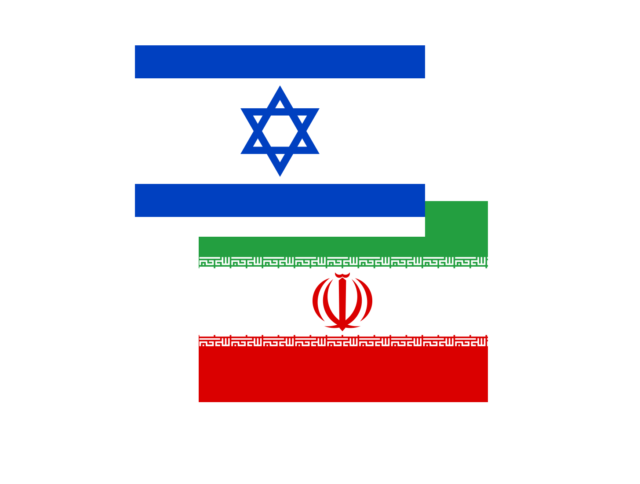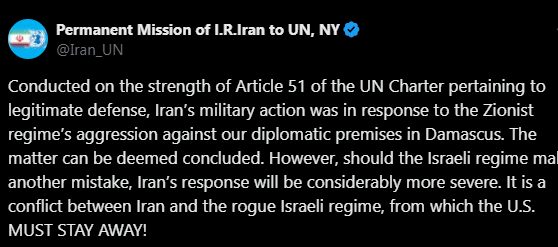
Geopolitical Report ISSN 2785-2598 Volume 41 Issue 11
SpecialEurasia OSINT Team
Executive Summary
The recent escalation between Iran and Israel, marked by Iran’s unprecedented direct attack on Israeli territory, presents a significant threat to regional stability in the Middle East and global security.
The attack, comprising hundreds of missiles and drones, underscores the intensification of hostilities between these longstanding adversaries.
This report provides an analysis of the background, key actors, current situation, threat assessment, and regional/global implications of the conflict.
Background Information
Deep-seated geopolitical rivalries, ideological differences, and regional power struggles root the historical context of hostility between Iran and Israel.
Iran’s support for proxy groups such as Hezbollah and Hamas, coupled with its pursuit of nuclear capabilities and anti-Israel rhetoric, has fuelled longstanding animosity. Recent events, including the Israeli airstrike on an Iranian consulate in Syria and Iran’s retaliatory measures, have exacerbated tensions, setting the stage for the latest escalation.
In this context of escalating tensions, the continued Israeli-Palestinian conflict following Hamas’ attack on October 7th, 2023, has intensified the volatile situation in the Middle East, particularly with the onset of the Israeli military operation in the Gaza Strip, resulting in significant casualties numbering in the thousands.
Key Actors and Stakeholders
Primary actors in the conflict include Iran, Israel, and their respective allies. Iran’s Islamic Revolutionary Guard Corps (IRGC) plays a central role in orchestrating military operations and shaping Iran’s regional strategy.
Israel, with its advanced military capabilities and close ties to Western powers, remains a key player in the Middle East. The involvement of the United States, the United Kingdom, and France in supporting Israel’s defence underscores the international dimensions of the conflict.
Current Situation Analysis
Based on initial reports and information from local sources, the Iranian assault appears to have resulted in relatively limited damage, with most suicide drones and missiles intercepted by Israeli defence forces in collaboration with allies from Tel Aviv. Iran’s mission to the United Nations has indicated that, following the deployment of drones towards Israel, Tehran considers its retaliatory action for the attack on its diplomatic compound in Damascus to be concluded.

Threat Assessment
The ongoing conflict poses significant security threats to Iran, Israel, and the broader region. Using sophisticated military technology increases the risk of civilian casualties, infrastructure damage, and wider destabilisation. Moreover, the involvement of external actors raises the potential for escalation and broader regional conflict, with implications for international security and stability.
Risk Scenarios
- Escalation to Wider Regional Conflict. With tensions already high and both Iran and Israel deeply entrenched in their positions, there is a significant risk of the current conflict expanding into a broader regional war. This scenario could involve the activation of alliances, such as Iran’s ties with proxy groups like Hezbollah in Lebanon and Houthi in Yemen as well as pro-Iranian groups in Iraq and Syria, potentially drawing in neighbouring countries and escalating the conflict to a larger scale.
- Proxy Warfare and Terrorism. The involvement of proxy groups supported by both Iran and Israel poses a considerable risk of proxy warfare and terrorism. These groups could exploit the conflict to launch attacks against each other’s interests, as well as against civilian populations in the region. Such actions could further destabilise the Middle East and lead to widespread insecurity.
- Humanitarian Crisis and Civilian Casualties. Continued military operations, including airstrikes and ground incursions, increase the likelihood of a humanitarian crisis in affected areas, particularly in the Gaza Strip. The civilian population, already vulnerable due to prolonged conflict, faces the risk of displacement, injury, and loss of life. The potential for large-scale civilian casualties and displacement poses significant challenges for humanitarian organisations and regional stability.
Conclusion/Recommendations
In conclusion, the recent escalation between Iran and Israel represents a grave threat to regional stability and global security. Urgent diplomatic efforts need to be made to de-escalate tensions, address underlying grievances, and prevent further violence.
Failure to mitigate the risk of conflict could cause widespread humanitarian suffering, destabilisation, and broader geopolitical ramifications.
The United States, in coordination with its allies and regional partners, must pursue a proactive approach to promote peace, security, and stability in the Middle East.
*Last Update: April 14th, 2024 – Time: 08.00 am CET
Read also | Multiple Perspectives Analysis of the Israeli Palestinian Conflict: From the Local Picture to the Challenge for Global Hegemony |
For further information, analysis, and reports on the Middle East and Iran-Israel confrontation, contact us at info@specialeurasia.com.



